By request of Waxy reader Logan Ingalls, I spent most of the day tracking down the origins of the Plane On A Treadmill physics puzzle/meme. I figured this would be simple, but six hours later, I’ve combed through archives of the web, Usenet, magazines, academic journal, physics websites, and hundreds of discussion forums looking for the source.
There have been a couple thought experiments that came close, but still different enough that they can’t be considered the source. Jason Scott found this Usenet post from September 1990, which sounded promising:
There is nothing special about the ground as a reference plane! Consider a large flatbed truck moving at 80 mph from east to west. Does the truck’s velocity have ANY effect on the airplane’s ability to fly? Now try to land on the truck….the velocity of the truck becomes *real* important!
O.K., I’ll carry my reductio-ad-absurdum one step more. I mount the entire state of california on a conveyor belt. Initially my conveyor belt is at rest. I take off, climb to some high altitude, and then key my mike 4 times which sets the ground into motion. Does my plane suddenly stop flying?
Very similar, but key differences in the question (and a five-year-gap before it caught on) suggest that this didn’t inspire the puzzle.
So, where did it come from? The earliest reference to it that I can find is this post to the PhysOrg Forums, dated July 19, 2005. It seems unlikely that some random poster on a physics message board would have invented it, but as far as I can tell, this is the case. Update: Its appearance online goes back to a Russian discussion forum in 2003. Read the updates at the bottom of the post for more.
I’ve tried to contact “dirak” through the PhysOrg site to get a decisive answer, but since he hasn’t posted a new message since July 2006, I think I’m out of luck. Looking for his username turns up some Slashdot submissions, all anonymous, and that’s about it. I’d even tried to contact the PhysOrg forum creators, but they’re extremely protective about their own privacy, too. As a desperate measure to locate the PhysOrg folks, I then tried to track down the freelance writers that wrote for PhysOrg (through Myspace and Facebook), and am waiting for those leads to respond. Update: Dirak responded! Read the updates below.
There’s no reference to the puzzle anywhere before July 2005, and no reference to it again until October 2005, suggesting that the rapidly-expanding PhysOrg thread led to users cross-posting it to other forums to get advice.
One of the earliest references is from November 15, 2005 on this discussion thread from Flightinfo.com, a popular aviation forum for serious pilots. Often cited in other messages from 2005, the Flightinfo thread was eventually removed from the site entirely in late 2006. On November 27, it spread further when an AVWeb columnist wrote a long article (also now offline) about how the controversy was spreading in the pilot community.
At this point, it was appearing on several message boards, inspiring heated debate everywhere it went. In December 2005, the question was posed to the Straight Dope discussion forum with no clear answers. A few weeks later, Cecil Adams himself addressed the question in his February 3, 2006 column. Cecil’s syndicated column broke the question into the mainstream. A few days later, Jason Kottke started his obsession with the question and the rest is history. Mythbusters’ elaborate tests were intended to answer the question for good, but it seems to have only strengthened the resolve of its detractors.
So until I hear back from “dirak,” or manage to contact PhysOrg, I’m going to consider this case closed. (Needless to say, if you can find an earlier reference or have any other information, please let me know.)
Updated February 7: Unbelievably, “Dirak” (his real name’s Andrew) responded to my private message through the PhysOrg forums! He says, “Yes, I’m sure I was the first who brought this topic to the English-speaking internet. However, I wasn’t the one who invented this question. I’m half-Russian and I read about it on one of Russian forums back in 2005.”
He continues, “I looked for that thread for you, here it is (it’s in Russian). The first guy (shipwreck) wrote about it in 2003 and in his first post he says that they were arguing about it in his college. shipwreck is an unregistered user on that board, so I’m not sure if it’s possible to contact him at all. Hope this helps you.”
Incredible. So, this brings its appearance online back to August 4, 2003. Any Russians out there want to carry on the search? Trying to contact “Shipwreck” would be the next step.
Also: Want me to research another meme? Email or IM me and I’ll give it a shot. Whee!




